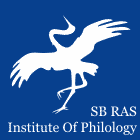 |
|
||||||||||||
|
Institute of Philology of
the Siberian Branch of Russian Academy of Sciences |
|
||||||||||||
|
|||||||||||||
DOI: 10.25205/2307-1737 Roskomnadzor certificate number Эл № ФС 77-84784 | |
| Kritika i Semiotika (Critique and Semiotics) | |
|
Article
Authors: Irina V. Zykova, Federica Ruggeri Institute of Linguistics of the Russian Academy of Sciences, Moscow, Russian Federation; Moscow State Linguistic University, Moscow, Russian Federation
Abstract: The paper highlights the most important moments in the history of gestural linguistics. One of its key issues concerns the peculiarities of the interaction of verbal and kinetic means that are involved in rendering human emotions and feelings in the processes of interpersonal communication. During the analysis of modern concepts in the field of language theory, linguistics of emotions and linguistic pragmatics, three types of emotive units are identified for further research: direct and figurative names of emotions and feelings and emotive speech acts. The connection of these types of emotive units with pragmatic gestures has been established. Based on the criteria developed in the research, two interviews were selected from the Italian TV show “Che tempo che fa” with the running time of about 35 minutes. The applied complex methodology, including the stages of markup and deep annotation of the material, let us establish the most relevant formal and semantic parameters of the interaction of emotive units and manual gestures used by the talk show participants. The formal parameters include “(a)synchronization of the emotive unit and gesture” and “boundaries of the gesture accompanying an emotive unit”. The semantic parameters are “hand-edness”, “direction of gesture movement”, “domain of gesture acting” and “palm configuration”. The research results also involve: the established specifics of the distribution of three types of emotive units in the analyzed TV interviews; the stated quantitative indicators of the ratio of emotive units accompanied and not accompanied by hand gestures; the discovered patterns of correspondence between gestures and certain types of emotive units and the character of the semantic (coreferent) connection of a manual gesture with one or another type of an emotive unit. Keywords: gestural linguistics, emotive units, hand gesture, TV show, TV interview, the Italian linguoculture Bibliography: Barros P., Churamani N., Lakomkin E., Siqueira H., Sutherland A., Wermter S. The OMGemotion behavior dataset. 2018, arXiv:1803.05434 Bressem J., Müller C. Body Language Communication: An International Handbook on Multimodality in Human Interaction. Berlin, Degruyter Mouton Press, 2014, 1086 p. Calbris G. Elements of meaning in gesture. Amsterdam, Philadelphia, John Benjamins Publishing Company, 2011, 378 p. Campisi E. What is gesture. Roma, Carocci Editore, 2018, 124 p. (in Italian) Caon F. Dictionary of Italian gestures. An intercultural perspective. Roma, Guerra edizioni, 2010, 224 p. (in Italian) Cienki A. Cognitive Linguistics: Language and gestures as expressions of conceptualization. In: Body – Language – Communication: An International Handbook on Multimodality in Human Interaction. Berlin, The Gruyter Mouton, 2013, pp. 182–201. Cienki A., Giansante G. Conversational framing in televised political discourse: A comparison from the 2008 elections in the United States and Italy. Journal of Language and Politics, 2014, no. 13 (2), pp. 255–288. Dael N., Goudbeek M., Scherer K. R. Perceived gesture dynamics in nonverbal expression of emotion. Perception, 2013, vol. 42, pp. 642–657. Diadori P. Speechless. 100 gestures of Italians. Roma, Bonacci editore, 1990, 136 p. (in Italian) Efron D. Gesture, race and culture: A tentative study of the spatio-temporal and linguistic aspects of the gestural behaviour of Eastern Jews and Southern Italians in New York City, Living under Similar as Well as Different Environ-mental Conditions. The Hague, Mouton De Gruyter, 1972, 226 p. Gak V. G. Language transformations. Types of language transformations. Factors and spheres of implementation of linguistic transformations. Moscow, Librocom Publ., 2016, 408 p. (in Russ.) Grishina E. A. Russian gesticulation from a linguistic point of view. Moscow, YaSK Publ., 2017, 744 p. (in Russ.) Halliday M. A. K. Language as social semiotic. The social interpretation of language and meaning. London, Edward Arnold (Publishers) Ltd, 1978, 256 p. Ionova S. V. Emotional dominant unit of the text: some linguistic aspects of the study. Bulletin of the Volgograd State University, Series 2, Linguistics, 2023, vol. 22 (1), pp. 13–27. (in Russ.) Iriskhanova O. K. (ed.) Multimodal studies of discourse. Moscow, YaSK Publ., 2021, 448 p. (in Russ.) Iriskhanova O. K. On some issues of cognitive poetics of gestures: gestures “poetic” vs “prosaic”. Cognitive studies of language, 2019, no. 37, pp. 989–994. (in Russ.) Izard K. E. Psychology of emotions. St. Petersburg, Peter Publ., 1999, 464 p. (in Russ.) Kendon A. Some relationships between body motion and speech: An analysis of an example. In: Siegman A., Pope B. (eds.). Studies in dyadic communication. New York, 1972, pp. 177–210. Kendon A. Gesture: Visible action as utterance. Cambridge, Cambridge Uni. Press, 2004, 400 p. Kibrik A. A. Multimodal Linguistics. In: Cognitive research – IV. Moscow, IP RAS, 2010, pp. 134–152. (in Russ.) Kiose M. I. Speech and gesture orchestras in the film frame. Argumentative and descriptive discourse. Cognitive studies of language, 2021, no. 47, pp. 255–270. (in Russ.) Kipp M., Martin J.-C. Gesture and emotion: Can basic gestural form features discrminate emotions? In: Proceedings of the International Conference on Affective Computing and Intelligent Interaction (ACII-09). IEEE Press, 2009. DOI 10.1109/ACII.2009.5349544 Kita S. The temporal relationship between gesture and speech: A study of Japanese-English bilinguals. Master of Science work (MS), Department of psychology. Chicago, The Uni. of Chicago, 1990. Kövecses Z. Metaphor and emotion. Cambridge, Cambridge Uni. Press, 2000. 242 p. Kreidlin G. E. Nonverbal semiotics: Body language and natural language. Moscow, Literary Review, 2002, 592 p. (in Russ.) Kreidlin G. E. Mechanisms of interaction of verbal and nonverbal units in dialogue IIa. Deictic gestures and their types. In: Computational linguistics and intelligent technologies. Proceedings of the international conference “Dialogue 2007”. Moscow, 2007, pp. 320–327. (in Russ.) Kress G., Van Leeuwen T. Reading images: multimodal resources in teaching of organic chemistry. London, New York, Routledge, 2006, 310 p. Lakoff G., Johnson M. Metaphors we live by. Chicago, Uni. of Chicago Press, 1980, 256 p. Litvinenko A. O., Nikolaeva Yu. V., Kibrik A. A. Annotation of Russian manual gestures: theoretical and practical issues. In: Computational linguistics and intellectual technologies: based on the materials of the international conference “Dialogue 2017” (Moscow, May 31 – June 3, 2017). Moscow, 2017, iss. 16 (23), vol. 2, pp. 271–286. (in Russ.) Litvinenko A. O., Nikolaeva Yu. V., Kibrik A. A., Fedorova O. V. “Russian Pear Chats and Stories”: Manual Annotation. Version 14.12.2018. URL: http://multidiscourse.ru McNeill D. Hand and mind. What gestures reveal about thought. Chicago, London, The Uni. of Chicago Press, 1995, 416 p. Niemeier S., Dirven R. (eds.). The Language of Emotions: Conceptualization, expression, and theoretical foundation. Amsterdam, Philadelphia, John Benjamins Publ., 1997, 333 p. Nikolaeva Yu. V. Pragmatic gestures in Russian retellings of “The Pear Stories”. The Russian Journal of Cognitive Science, 2017, vol. 4 (2–3), pp. 6–12. O’Toole M. The language of displayed art. London, New York, Routledge, 2010, 296 p. Poggi I. The words of the body. Introduction to multimodal communication. Roma, Carocci Editore, 2013, 160 p. (in Italian) Poggi I., Magno-Caldognetto E. Emotional speech. Cognitive, linguistic and phonetic aspects. In: Atti del Convegno “Il parlato italiano”. Napoli, D’Auria Editore, 2004, 21 p. (in Italian) Popova T. I. Television interview: semantic and pragmatic aspects. Dr. Philol. Sci. Diss. St. Petersburg, 2004, 432 p. (in Russ.) Prokofieva O. N. Cognitive and pragmatic factors of the joint use of verbal and gestural means in descriptive discourse. Cand. Philol. Sci. Diss. Moscow, 2022, 295 p. Savchuk S. O. What does gestural linguistics contribute to the study of discourse. Cognitive studies of language, 2021, iss. 1 (44), pp. 213–220. (in Russ.) Savchuk S., Makhova A. Multimodal Russian Corpus and its use in emotional studies. Russian Journal of Communication, 2021, no. 13 (1), pp. 42–61. DOI 10.1080/19409419.2021.1887991 Shakhovsky V. I. Emotions as an object of research in linguistics. Questions of psycholinguistics, 2009, no. 9, pp. 29–42. (in Russ.) Teliya V. N. Russian phraseology: Semantic, pragmatic and linguoculturological aspects. Moscow, Languages of Russian culture, 1996, 288 p. (in Russ.) Trufanova I. V. Pragmatics of non-direct speech proper. Diss. of Dr. Philol. Sci. Nizhny Novgorod, 2001, 696 p. (in Russ.) Volterra V., Beronesi S., Massoni P. How does gestural communication become language? In: Volterra V., Erting C. J. (eds.). From gesture to language in hearing and deaf children. Berlin, Springer-Verlag, 1990, pp. 205–218. |
 |
Institute of Philology Nikolaeva st., 8, Novosibirsk, 630090, Russian Federation +7-383-330-15-18, ifl@philology.nsc.ru |
© Institute of Philology |


